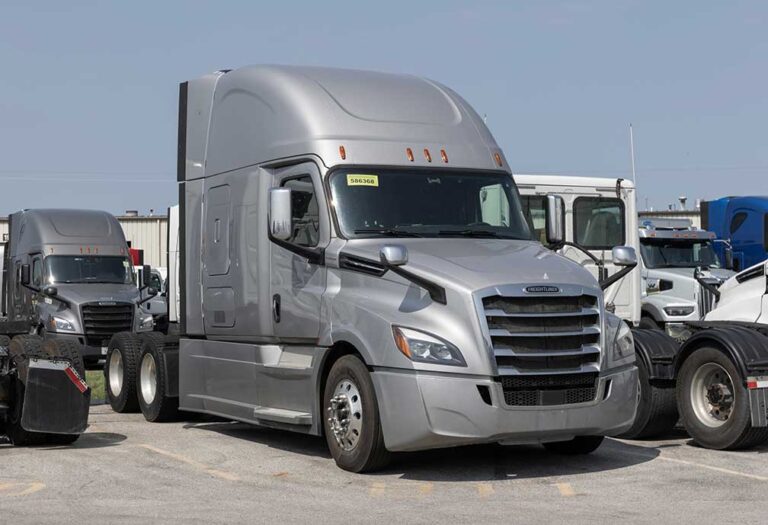“Is this a good time to buy a truck?”
It’s a question heard often in the industry, and the answer is usually the same: “Maybe … but then again, maybe not.”
This is obviously not a very satisfactory answer, but the truth is that whether you’re thinking about adding another truck to a small fleet or buying your first truck and striking out as an owner-operator, there are numerous factors to take into consideration.
Consider capacity and rates.
When it comes to the freight market, capacity rules. Capacity, or the number of trucks available to haul freight, is the “supply” side of the supply / demand equation.
The more freight that needs to be moved, the more demand there is for trucks to haul that freight.
For the past couple of years, the supply of available trucks has been too high; this has kept freight rates low. In fact, rates have been so low for so long that thousands of carriers — mostly one- or two-truck outfits, but also some larger ones — to leave the industry.
If current signs are correct, however, things are beginning to change. The trucking industry is about to enter a growth period in the next truck-freight cycle.
The conditions for buying a truck and starting a trucking business are improving.
One indicator that now might be a good time to buy a truck is that spot rates are looking better.
According to DAT Freight and Analytics, which hosts the country’s largest load board, November spot rates for dry van loads were up 0.5% from a year ago on the average, while flatbed spot rates were up 2.0% over November 2023 rates. Refrigerated spot rates were down 1.7% compared with a year ago, but analysts believe they should rebound nicely once harvesting commences in the new year.
A Dec. 16 report from industry analyst FTR Transportation Intelligence pointed out that consumer prices rose in November, “with food prices notably contributing to producer-level inflation.” Commentary included with the report also pointed out that mortgage rates have been declining, a good sign for the housing market and the flatbed industry.
Another interesting statistic mentioned in the FTR release was Applications for New Businesses, which surged by 5.5% in November. That’s the largest increase since April of 2021 — and a good sign that confidence in the economy is growing.
Interest rates could drop in the near future.
If mortgage rates are falling, then interest rates on loans for trucking equipment can’t be far behind. Those rates may soon have reason to decline further.
The Federal Open Market Committee, the branch of the Federal Reserve that sets the interest rate range for money that commercial banks borrow and lend their excess reserves to one another, was scheduled to meet this week, on Dec. 18. Economists predict they will cut interest rates by another .25%.
Some economists are urging caution, claiming that a further cut in interest rates could spur inflation. That’s not necessarily a bad thing for trucking, however, if inflation results in more freight to haul — which will increase the demand side of the freight equation.
Used truck prices are falling.
While freight rates are slowly beginning to rise and there’s a possibility that interest rates might come down, used truck prices are still falling from their previous record highs.
According to data received from industry analyst ACT Research, the number of used trucks sold in November increased by 24% from November 2023 levels. The average used truck sold in November was priced 4% lower than a year ago and had 1% fewer miles, PLUS, the average used truck was 2% younger in age.
Inventories are still at record high levels, a good sign for potential buyers.
The recent presidential election may have impacted both U.S. economic factors and used truck sales, as consumer confidence in the economy has risen. It’s possible that some November sales were made by buyers who waited for the election results before investing, but no one knows for sure.
Prices for new trucks will rise.
While future prices of used trucks aren’t certain, it IS certain that the prices of new trucks will be going up. That’s because government mandates for both fuel economy and emissions take effect with the 2027 models. The Environmental Protection Agency’s (EPA) new standards make manufacturers responsible for the increased usable life of each truck. OEMs will most likely respond by increasing the length of warranty coverage, charging a higher price upfront for the additional maintenance work.
Because buyers are expected to “pre-buy,” stocking up on equipment before the new standards and higher costs go into effect, new truck prices for 2025 and 2026 models are expected to be higher, and some buyers will turn to the used truck market. When that happens, used truck prices should begin climbing again.
Numerous factors impact the freight business.
So, while freight rates are slowly rising, used truck prices are down and interest rates are improving, the window for starting a new trucking business may be easing open.
The caveat, however, is that success isn’t guaranteed. Some good carriers fail in a good market, while some poorly run carriers succeed in a down market. Management, especially decision-making ability, local markets and good, old-fashioned luck are still in the equation.
One other factor that will impact the trucking business in 2025 is the cost of diesel fuel. The average U.S. cost per gallon of on-road diesel is $3.49, according to the U.S. Energy Information Administration (EIA). That price is down 53 cents from a year ago and $1.33 from two years ago.
The EIA projects that crude oil prices will remain stable throughout 2025, so diesel prices should remain constant.
President-elect Trump made energy independence a part of his election message and is expected to increase U.S. oil production, as he did in his first term. However, fuel prices can be impacted by global events, such as the ongoing military conflicts in the Middle East and Ukraine, and by weather events.
In other words, there’s no “sure-fire” prediction.
It’s important for carriers to have a fuel surcharge policy — a mechanism to pass along higher costs to customers — in case diesel prices rise. An internet search will bring up tables used by other carriers, or a carrier can make their own. Carriers that deal with brokers must understand how fuel prices impact profitability and incorporate that information into load decisions.
Depending on the source of information, the long drought in trucking profitability may be entering a new phase that could be very beneficial for potential business owners. As trucking conditions change, the next few months could offer the starting point some entrepreneurs have been waiting for.
Cliff Abbott is an experienced commercial vehicle driver and owner-operator who still holds a CDL in his home state of Alabama. In nearly 40 years in trucking, he’s been an instructor and trainer and has managed safety and recruiting operations for several carriers. Having never lost his love of the road, Cliff has written a book and hundreds of songs and has been writing for The Trucker for more than a decade.














